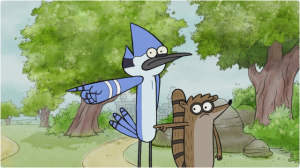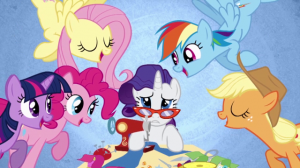When an exasperated Bugs tries to passive-aggressively flee a misguided Lola Bunny from her insane belief that the two are dated, he spouts the usual one-liners that would normally invoke an exasperated laugh-track, only to have her respond in kind, invoking another theoretical laugh track. Here, however, Bugs ends up crushed under a giant, weighted barbell, his eyes popping out momentarily as a goofy weight-lifter looks on, confused. Don’t worry, Bugs is a pro. An animated pro.
Welcome to the new animated sitcom. Here, the stories are taken from the well-worn box of typical sitcom tropes and conventions and placed in animated form, but the kicker is that we allow those characters to get hurt, and our conflicts can involve magic and surreal insanity and goofy chaos to resolve them. These characters are real in spirit but fake in action. You’ve seen them before, but not quite like this.
The new animated sitcom differs from the old animated sitcom in that they embrace their cartoony elements more than ever before. The creators adore their squash and stretch roots, their sillier and exaggerated plot-lines, their anvils or otherwise heavy-objects crushing or hitting their characters flat along with their rooted, serial dilemmas easily solved within a 22-minute period. They aren’t The Simpsons, or King of the Hill, or Bob’s Burgers. They’re not Animaniacs, Freakazoid, or Spongebob. And they aren’t Batman, Justice League, or Ben-10. They are an oddly perfect mix of the three.
It was birthed in the fires of Family Guy, but sloppily regulated to cutaways and minor sight gags. It was fine, but MacFarlane’s titular show was always emphatic on the pop-culture gag and, in the end, falling back on the typical sitcom tropes we know and love (or tolerate). While Family Guy post-cancellation has been a hodge-podge of a mess (American Dad seems to be the stronger show nowadays, with also an firmer grip on its cartooniness and sitcomy-ness), the first three seasons broke the physical wall of what an animated sitcom could and should do. It said that animation should and could be, at times, goofy and silly. It is a fucking cartoon after all; maybe, on occasion, can it act like one?
Of course, critics don’t really care too much for such antics; when animated sitcoms get too “cartoony,” this is considered a bad thing. Take a moment and think about this, and reveal in the unaware irony. It’s good to know that the newer batch of critics and viewers, those of use who grew up on Rocko’s Modern Life, Angry Beavers, Invader Zim, and Eek The Cat are a little more lenient when, god-forbid, a cartoon act like a cartoon sometimes. Of course, our tastes and expectations change. We’re older and we’d like to explore older themes. We love our wallabies and beavers and aliens and (non)helpful felines, but now we want something a bit more deeper.
Family Guy was the trigger, but the first cartoon to really embrace cartoon and sitcom alike was Regular Show. It’s somewhat hindered in it’s 2 x eleven minute short format, but it’s a cartoon and a sitcom all the same. Two kids with a somewhat backbreaking job while trying to find ways to slack off and party? How many times have you seen shows like this come and go on ABC, CBS, FOX, and NBC? Of course, those shows don’t end with a powerful being of the likes of Party Pete floating in the air and glowing. Or it doesn’t have a song that sends objects and creatures, literally, to the moon.
And yet there’s a heartfelt style to it. The dialogue is goofy and the beats in the early parts of the episodes are quiet, low-key, verbal based. They say they’re “pissed off” and “what the ‘f’.” They are frustrated by crappy video games and annoying friends, but are somewhat impressed by their boss who both hates and loves them. Regular Show kinda reminds me of the new Comedy Central show Workaholics, but more cartoony, more appreciative of its animated format. A few times, I’ll say to myself, “Ahh, so that’s why this is animated.” I couldn’t say that for King of the Hill.
People will be confused and ask who this is for. Who is the audience? It’s for you, guys. Anyone who understand the nature of demographics is in that demographic. Another great irony. Of course it doesn’t get as deep or life-reflexive as a typical sitcom. There are no character or story arcs as far as I can see. But re-occurring characters are committed to their roles, and the characters have a real, grounded place and real, grounded stakes.
Enter Lauren Faust and My Little Pony: Friendship is Magic.
I wrote about this before, but My Little Pony is the first real show to gauge itself as both a sitcom and a cartoon. It’s easy to focus on the cartoon elements, due to the colorful cast, the pun-based terminology, the expressions and squash-and-stretch emphasis, and the crazy situations the characters get into. However, the characters are deep and unique, the stories are grounded (in MLP-world terms), and there is indeed a story arc, or at least a consistency to the world Faust has created. The only thing that holds it back is it’s perceived demographic (young girls), but as far as the internet is concerned, My Little Pony is for everyone. And it’s a full 22-minutes, too.
Other shows can be argued to be part of the Animated Sitcom, 2.0, but fall short. Ugly Americans utilizes an exotic cast of wizards, werewolves, and robots as legit, fleshed-out characters; it’s limited animation holds it back, however, keeping it along side Futurama and most content on Adult Swim. It’s rare to see the characters of those shows really embrace their cartoony natures. I won’t count action cartoons either, as 1) they aren’t really cartoony and 2) they really aren’t sitcoms. (Batman: Brave and the Bold comes close, but it’s too removed from the “sitcom” trope and is firmly in the action realm.) Phineas and Ferb seem like a good candidate, although character depth is more or less focused on the characters of Candice and Doofenshmirtz, there’s no central theme (beyond two boys making the most of their summer), the 11-minute format is too restricting, and warmer, subtler moments come too few and far in-between to register any poignancy (although there is quite a bit of potential on the peripheral, like Doofenshmirtz’s daughter.) Likewise with Fairly Oddparents and TUFF Puppy. In fact, if you want something closer to compare this phenomenon to, look to the classic Disney Afternoon block from the 90s, where each ‘toon fully embrace it’s 24-minute timeframe for a solid, character-rich show with some pretty fun cartoony elements (although lacking in the sitcom department, there was a few basic elements from it, mostly among character relationships).
(As an aside: a lot of live-action kids TV shows seem much more cartoony than not these days, with their outlandish premises and storylines, like iCarly, The Wizards of Waverly Place, and Hannah Montana.)
With the new Looney Tunes Show embracing that dual role of both cartoon and sitcom, probably in the strongest fashion thus far (although it lacks both 1) the manic energy and 2) a coherent, fleshed-out world as tightly created as MLP), we’re slowly entering a brand new era of the late night, 8pm entertainment. It’s interesting to note that as of a few weeks ago Seth MacFarlane acquired the rights to reboot The Flintstones, arguably the first animated sitcom of its era, a show brimming with cartoony potential but held back by Hanna-Barbara’s limited animation. It’s interesting to see where he takes it; there is a chance that it will be a lame, pop-culture riddled mess, but there’s also a chance it could be a fairly fun, silly animated sitcom as well – after all, he did do typical cartoons before he received FOX money.
It will be interesting to see if Cartoon Network, Nick, or some of the outlier networks like Spike, Comedy Central, or FX start to snatch up sillier cartoon fare with a sitcom base. It would be nice to see more animated sitcoms embrace the “animated” portion of its namesake versus the “sitcom” part, and it looks like we’re seeing more of this in the coming years. Here’s hoping audiences love it as well.



Comments are closed